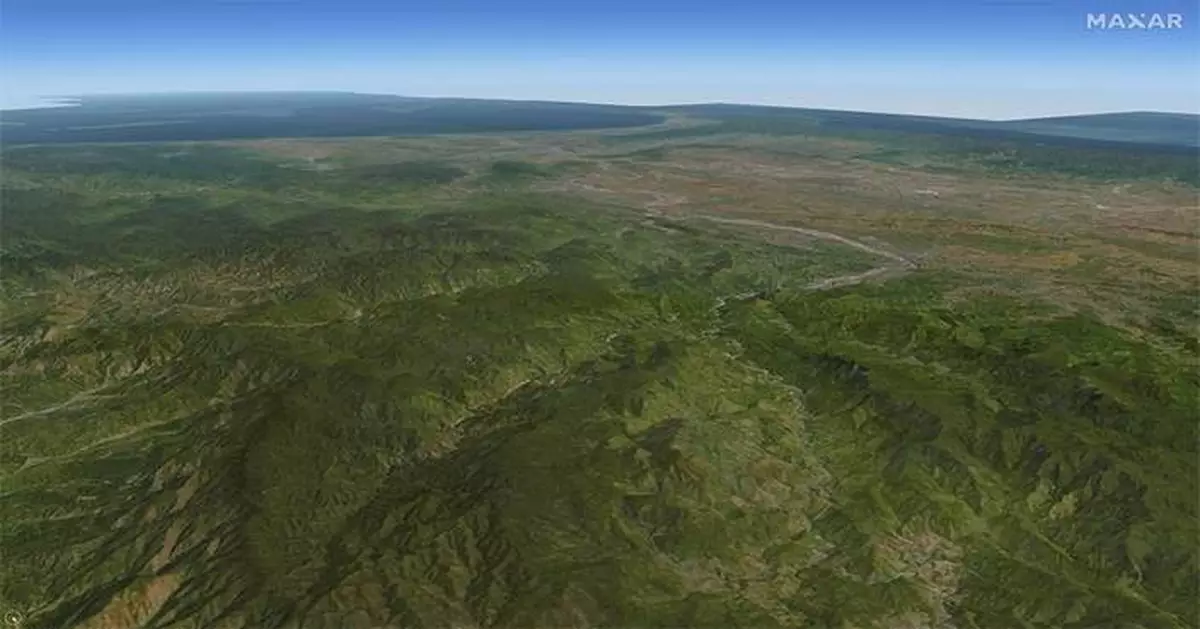WESTMINSTER, Colo.--(BUSINESS WIRE)--May 6, 2024--
Maxar Intelligence, a provider of secure, precise, geospatial intelligence, announced today a long-term agreement with Lockheed Martin to streamline the procurement and delivery of Maxar’s geospatial products for the F-35 Full Mission Simulator (FMS) flight simulation and training system.
This press release features multimedia. View the full release here: https://www.businesswire.com/news/home/20240506036893/en/
Maxar’s industry-leading 2D and 3D products serve as the geospatial foundation for the FMS, which provides a realistic representation of real-world operating environments to enhance pilot training and mission rehearsal. The new agreement establishes standardized pricing, licensing, and requirements for several Maxar products, including Dynamic basemaps and Precision3D, enabling F-35 customers to begin training and mission preparedness operations faster.
“Maxar Intelligence is excited to expand on our long-standing partnership with Lockheed Martin and further improve the F-35 Full Mission Simulator experience, which represents an industry gold standard for immersive training and mission readiness support,” said Susanne Hake, General Manager, U.S. Government, Maxar Intelligence. “Maxar’s geospatial products, particularly Precision3D, are critical to the success of this system. They enable the highly accurate, precise simulated real-world environments that are brought to life in the FMS, creating an immersive experience that helps improve pilot safety and enhance mission success.”
Maxar’s Precision3D Data Suite provides highly accurate and detailed 3D models of Earth with 50-centimeter resolution and absolute accuracy of 3 meters in all dimensions. The accuracy is achieved without ground control and is consistent on all surfaces and terrain types, including building facades. Precision3D provides a precise, true representation of Earth that not only reflects the terrain in all dimensions but also provides an accurate foundation for additional data sources through Precision3D Registration (P3DR™) georegistration.
In addition to Precision3D, the agreement covers Maxar’s Dynamic imagery basemaps, which utilize the latest innovations in mosaicking, color balancing and image processing to produce high-resolution, high-accuracy image layers configured to meet specific customer requirements.
About Maxar Intelligence
Maxar Intelligence is a provider of secure, precise, geospatial intelligence. We deliver disruptive value to government and commercial customers to help them monitor, understand and navigate our changing planet. Our unique approach combines decades of deep mission understanding and a proven commercial and defense foundation to deploy solutions and deliver insights with unrivaled speed, scale and cost effectiveness. For more information, visit www.maxar.com.


Maxar Intelligence's Precision3D Data Suite offers the most accurate representation of the Earth and is trusted by partners that demand precision for high-risk training operations, including Lockheed Martin's F-35 Full Mission Simulator. (Photo: Maxar Intelligence)
JACUMÉ, México (AP) — Near the towering border wall flanked by a U.S. Border Patrol vehicle, botanist Sula Vanderplank heard a quail in the scrub yelp “chi-ca-go,” a sound the birds use to signal they are separated from a mate or group.
Then silence.
A quail on the Mexican side called back, triggering a back-and-forth soundtrack that was both fitting and heartbreaking in an ecosystem split by an artificial barrier.
Vanderplank was among several botanists and citizen scientists participating in the Border Bioblitz near the Mexican community of Jacumé, about 60 miles (100 kilometers) east of Tijuana.
Roughly 1,000 volunteers armed with the iNaturalist app on their smartphones are documenting as many species as possible along the U.S.-Mexico border in May. Uploading photos to the app helps identify plants and animals, and records the coordinates of the location.
The hope is the information could lead to more protections for the region's natural richness, which is overshadowed by news of drug trafficking and migrant smuggling.
On a recent day, Bioblitz volunteers scrutinized a bright yellow blooming carpet of common Goldfields, a sharp contrast to the imposing steel bollards of the border wall topped with rolls of razor wire. Some navigated their way around piles of empty water jugs, a gray hoodie and empty cans of tuna fish left under the branches of native flora like the Tecate Cypress.
“There’s a fabulous amount of biodiversity here that’s traditionally been overlooked,” Vanderplank, of the binational program Baja Rare, said.
The efforts started in response to former President Donald Trump adding hundreds of miles of border walls that toppled untold numbers of saguaro cactuses in Arizona and passed through the biodiversity hotspot of Baja California.
“When the border wall construction began, we realized how little hard data we had, especially when it came to plants and small organisms,” Vanderplank said. “We don’t know what all we could lose.”
Since then, there has been a groundswell of initiatives to document the borderland’s flora and fauna as climate change coupled with habitat loss, pollution and development have hammered the world’s biodiversity. One estimate in 2019 warns that a million plant and animal species face extinction within decades, a rate of loss 1,000 times greater than expected.
The United Nations is expected hold a high-level meeting in Colombia of signatories to the Convention on Biological Diversity in October aiming to protect 30% of land, freshwater and oceans considered important for biodiversity by 2030, known as 30 by 30. Representatives from nearly 200 countries are expected to present plans on how they will meet conservation targets agreed upon in 2022.
Currently, 17% of terrestrial and 10% of marine areas are protected.
Baja California peninsula, which borders California and is home to Tijuana with one of Mexico's highest homicide rates, has more than 4,000 species of plants. A quarter of them are endemic and at least 400 plants are considered rare with little to no protection.
Flora and fauna that have gone extinct or are in danger of disappearing in the U.S., like the California red-legged frog, are thriving south of the border, producing specimens that are being used to bring back populations.
But the region’s crime deters many U.S. scientists from crossing the border. Mexico also is restricting permits for botanists and not allowing seeds to be collected, further curtailing the work, scientists say.
Bioblitz organizers work with local communities and say they take people only to areas deemed safe.
“You have to be really careful because of the violence,” said Jon Rebman, a curator of botany at the San Diego Natural History Museum, who has named 33 new plants for science from the southern California and Baja California region.
“It’s scary from that standpoint, yet those are the areas where we really need more information because there’s hardly any protected area on the south side,” he said.
Using the museum’s collection, Rebman made a list of 15 plant species endemic to Baja California and not seen since being collected nearly a century ago. He created a binational team to find them. So far, they have located 11.
Rebman also discovered two new plants to science in 2021 in a canyon off a Tijuana highway: the new species, Astragalus tijuanensis, and a new variety of the Astragalus brauntonii named lativexillum.
“I was worried they would go extinct before we even got them named,” Rebman said. “That tells you what type of area we’re working in.”
Tijuana-based botanist Mariana Fernandez of Expediciones Botánicas periodically checks on the plants. Working with Rebman, she is pushing Baja California to adopt more protections for its native plants. Currently only a fraction are on Mexico’s federal protection list.
She hopes the state will step in, while she also tries to build support by taking Tijuana residents and Baja officials on hikes.
“People are amazed that these things exist in Tijuana, and I hope to show more and more people so they can see the beauty, because we need that,” Fernandez said. “It’s important to not be impeded by the barriers that humans create.”
As border security increases with the number of people being displaced by natural disasters, violence and wars at record levels worldwide, more migrants are traipsing out to areas like the stretch near Jacumé. The tiny community of about 100 families includes members of the Kumeyaay tribe and sits across the border from an equally sparsely populated desert near the California town of Jacumba Hot Springs. Population: about 1,000.
The area has seen thousands of asylum seekers who wait for an opportunity to cross, usually in the cloak of darkness, and then camp again on the U.S. side after turning themselves in to U.S. Border Patrol agents.
Fernandez was among the botanists helping Bioblitz volunteers on the Mexican side near a crumbling crossing station from the 1920s.
“I never would have thought that there would be so much biodiversity on the border,” said Jocelyn Reyes, a student of Fernandez at La Universidad Autónoma de Baja California who stopped every few feet to hover over a plant and photograph its details. “It’s so interesting and makes you realize there’s so much worth saving.”

A California Horned Lizard is temporary held for classification during a botanical expedition with Universidad Autonoma de Baja California college students documenting native plants and species along the U.S.-Mexico border on Friday, April 19, 2024, in the Ejido Jacume in the Tecate Municipality of Baja California, Mexico. Botanists and citizen scientists armed with the iNaturalist app on their smartphones are recording the biodiversity along the U.S.-Mexico border in May. Called the Border Bioblitz, more than 1,000 volunteers are recording as many species as possible. (AP Photo/Damian Dovarganes)

Horses walk close to the US Mexico border Friday, April 19, 2024, in the Ejido Jacume in the Tecate Municipality of Baja California, Mexico. Botanists and citizen scientists armed with the iNaturalist app on their smartphones are recording the biodiversity along the U.S.-Mexico border in May. Called the Border Bioblitz, more than 1,000 volunteers are recording as many species as possible. (AP Photo/Damian Dovarganes)

Dr. Georges Seingier, Prof. Marine and Environmental Sciences at Baja California Autonomous University joins a botanical expedition with Universidad Autonoma de Baja California college students to document native plants along the U.S.- Mexico border on Friday, April 19, 2024, in the Ejido Jacume in the Tecate Municipality of Baja California, Mexico. The group near the Mexican community of Jacume, about (60 miles) 100 kilometers east of Tijuana, is one of several participating in the Border Bioblitz in which more than 1,000 volunteers throughout May record as many species as possible along the U.S.-Mexico border, a region plagued by drug trafficking and migrant smuggling that have overshadowed its natural richness. (AP Photo/Damian Dovarganes)

College students, members of Baja California's conservation organization Baja Rare, lead a botanical expedition to document native plants along the U.S.-Mexico border on Friday, April 19, 2024, in the Ejido Jacume in the Tecate municipality of Baja Calif., Mexico. The Baja California peninsula, which borders California and is home to Tijuana, one of the deadliest cities in the world, has more than 4,000 species of plants. According to scientists, a quarter of them are not found anywhere else, and some 200 plants are considered rare with little to no protection. (AP Photo/Damian Dovarganes)

A college student joins members of the California's Baja Rare conservation project leading a botanical expedition to document native plants along the U.S.- Mexico border on Friday, April 19, 2024, in the Ejido Jacume in the Tecate Municipality of Baja Calif., Mexico. Since then there has been a groundswell of initiatives to document the borderland's flora and fauna as climate change coupled with habitat loss, pollution and development have hammered the world's biodiversity, with one estimate in 2019 warning that a million plant and animal species face extinction within decades, a rate of loss 1,000 times greater than expected. (AP Photo/Damian Dovarganes)

Dr. Georges Seingier, Prof. Marine and Environmental Sciences at Baja California Autonomous University leads a botanical expedition with Universidad Autonoma de Baja California botanists and citizen scientists to document native plants along the U.S.- Mexico border on Friday, April 19, 2024, in the Ejido Jacume in the Tecate Municipality of Baja California, Mexico. Since then there has been a groundswell of initiatives to document the borderland's flora and fauna as climate change coupled with habitat loss, pollution and development have hammered the world's biodiversity, with one estimate in 2019 warning that a million plant and animal species face extinction within decades, a rate of loss 1,000 times greater than expected. (AP Photo/Damian Dovarganes)

Members of the Baja California's conservation Baja Rare project lead a botanical expedition with college students to document native plants along the U.S.-Mexico border on Friday, April 19, 2024, in the Ejido Jacume in the Tecate Municipality of Baja Calif., Mexico. The group near the Mexican community of Jacume, about (60 miles) 100 kilometers east of Tijuana, is one of several participating in the Border Bioblitz in which more than 1,000 volunteers throughout May record as many species as possible along the U.S.-Mexico border, a region plagued by drug trafficking and migrant smuggling that has overshadowed its natural richness. (AP Photo/Damian Dovarganes)

Lichen grows on native tree branches along the US-Mexico border on Friday, April 19, 2024, in the Ejido Jacume in the Tecate Municipality of Baja California, Mexico. Botanists and citizen scientists armed with the mobile cellphone iNaturalist app are recording the biodiversity along the U.S.-Mexico border in May. The Border Bioblitz has more than 1,000 volunteers recording as many species as possible. Flora and fauna that have gone extinct or are in danger of disappearing in the U.S. have been found to be thriving in remote spots south of the border, producing specimens that can then be used to bring back populations, scientists say. But the region's crime has deterred many U.S. scientists from crossing the border. (AP Photo/Damian Dovarganes)

Botanists and citizen scientists armed with the iNaturalist app on their smartphones record the biodiversity along the U.S.-Mexico border as bright yellow blooms carpet the ground, a sharp contrast to the imposing steel bollards of the border wall topped with rolls of razor wire as members of the California's Baja Rare project lead a botanical expedition with college students to document native plants along the US Mexico border on Friday, April 19, 2024, in the Ejido Jacume in the Tecate Municipality of Baja Calif., Mexico. (AP Photo/Damian Dovarganes)

Tijuana-based field botanist Mariana Fernandez of Expediciones Botanicas leads a botanical expedition with college students to document native plants along the U.S.- Mexico border on Friday, April 19, 2024, in the Ejido Jacume in the Tecate Municipality of Baja California, Mexico. Flora and fauna that have gone extinct or are in danger of disappearing in the U.S. have been found to be thriving in remote spots south of the border, producing specimens that can then be used to bring back populations, scientists say. But the region's crime has deterred many U.S. scientists from crossing the border. (AP Photo/Damian Dovarganes)

Botanists and citizen scientists armed with the iNaturalist app on their smartphones record the biodiversity along the U.S.-Mexico border as bright yellow blooms carpet the ground, a sharp contrast to the imposing steel bollards of the border wall topped with rolls of razor wire along the US Mexico border on Friday, April 19, 2024, near Botanists and citizen scientists armed with the iNaturalist app on their smartphones record the biodiversity along the U.S.-Mexico border as bright yellow blooms carpet the ground, a sharp contrast to the imposing steel bollards of the border wall topped with rolls of razor wire as members of the California's Baja Rare project lead a botanical expedition with college students to document native plants along the US Mexico border on Friday, April 19, 2024, near the Ejido Jacume in the Tecate Municipality of Baja Calif., Mexico. (AP Photo/Damian Dovarganes)

Bright yellow blooms carpet the ground, a sharp contrast to the imposing steel bollards of the border wall topped with rolls of razor wire as members of the California's Baja Rare conservation project lead a botanical expedition with botanists and citizen scientists to document native plants along the U.S.- Mexico border on Friday, April 19, 2024, in the Ejido Jacume in the Tecate Municipality of Baja Calif., Mexico. (AP Photo/Damian Dovarganes)























